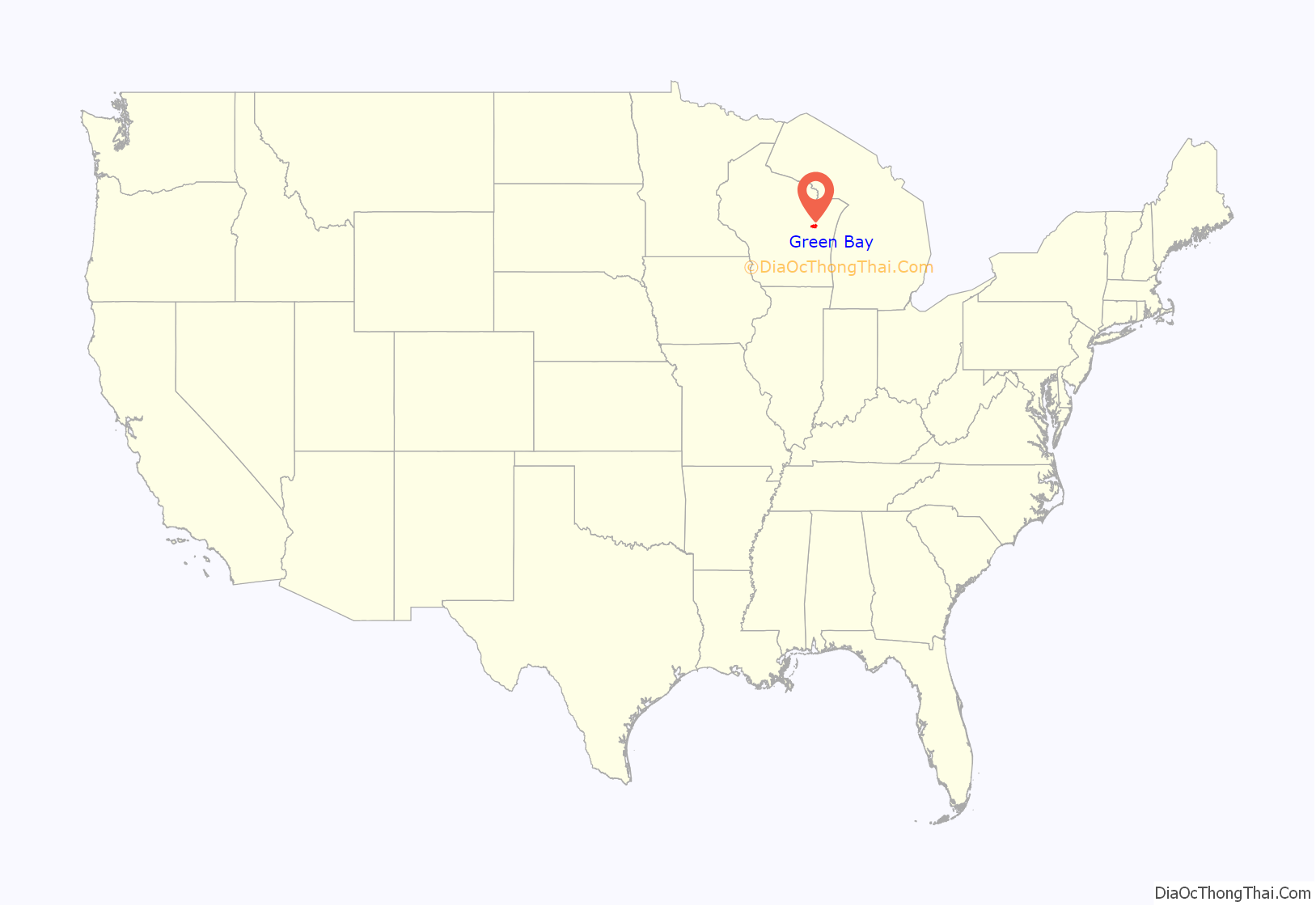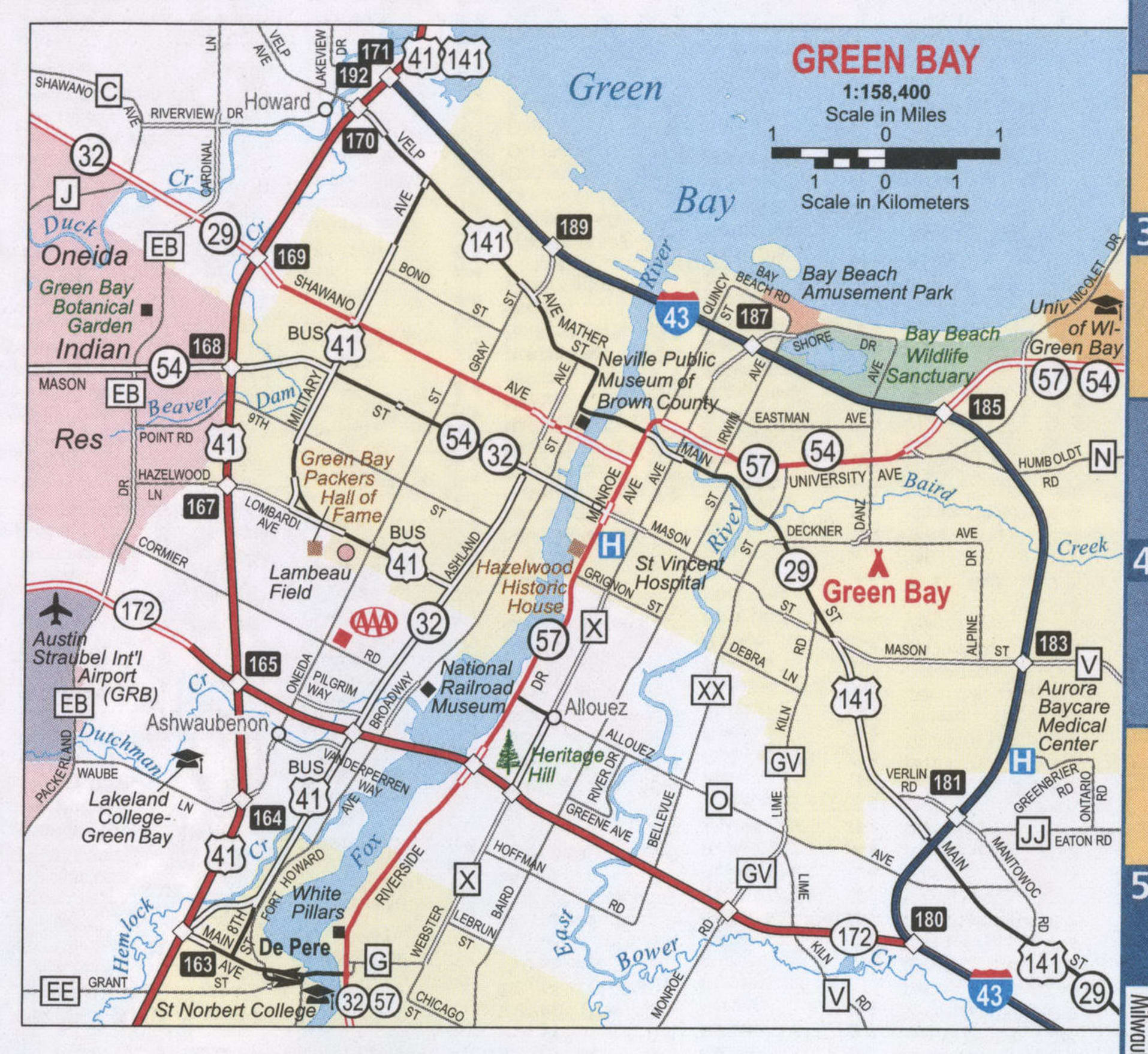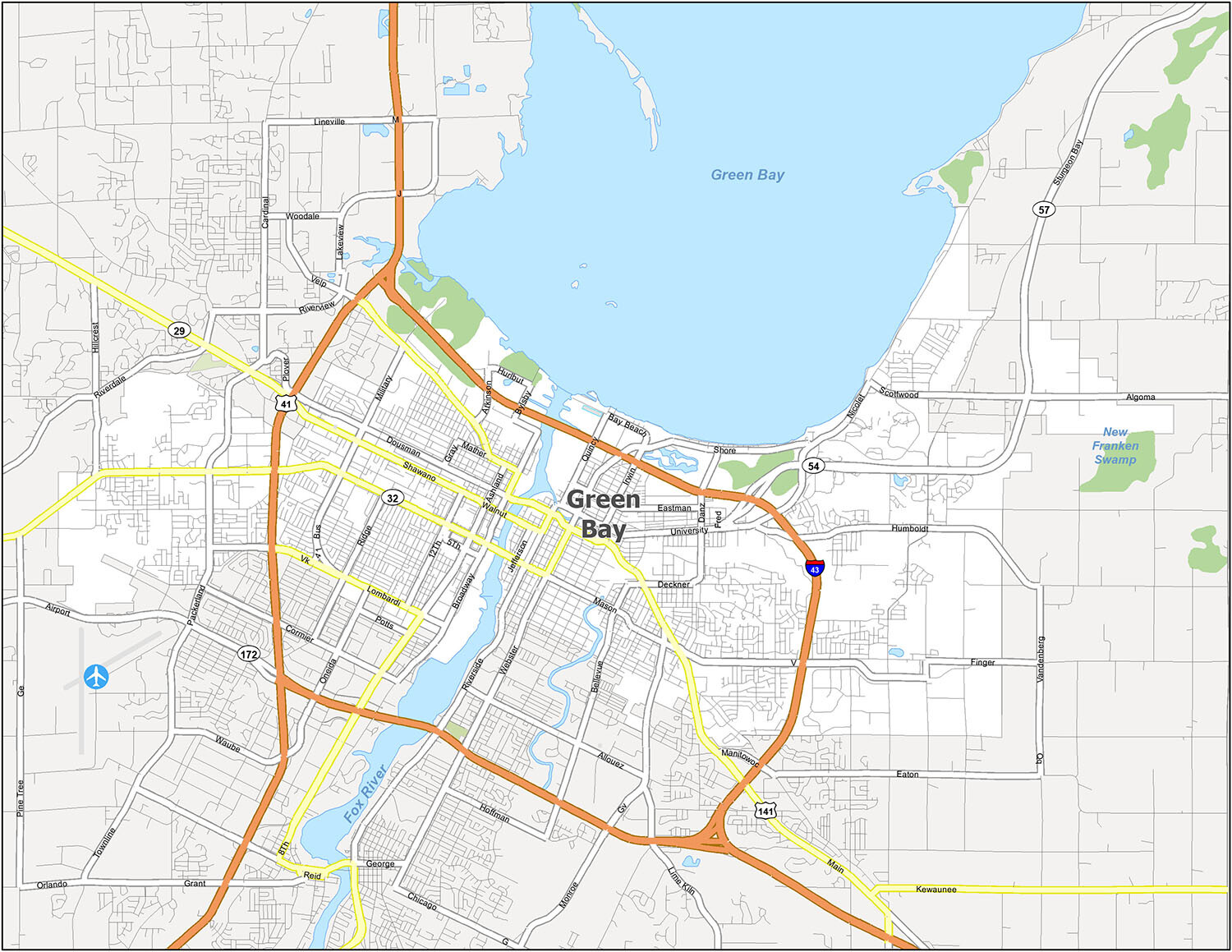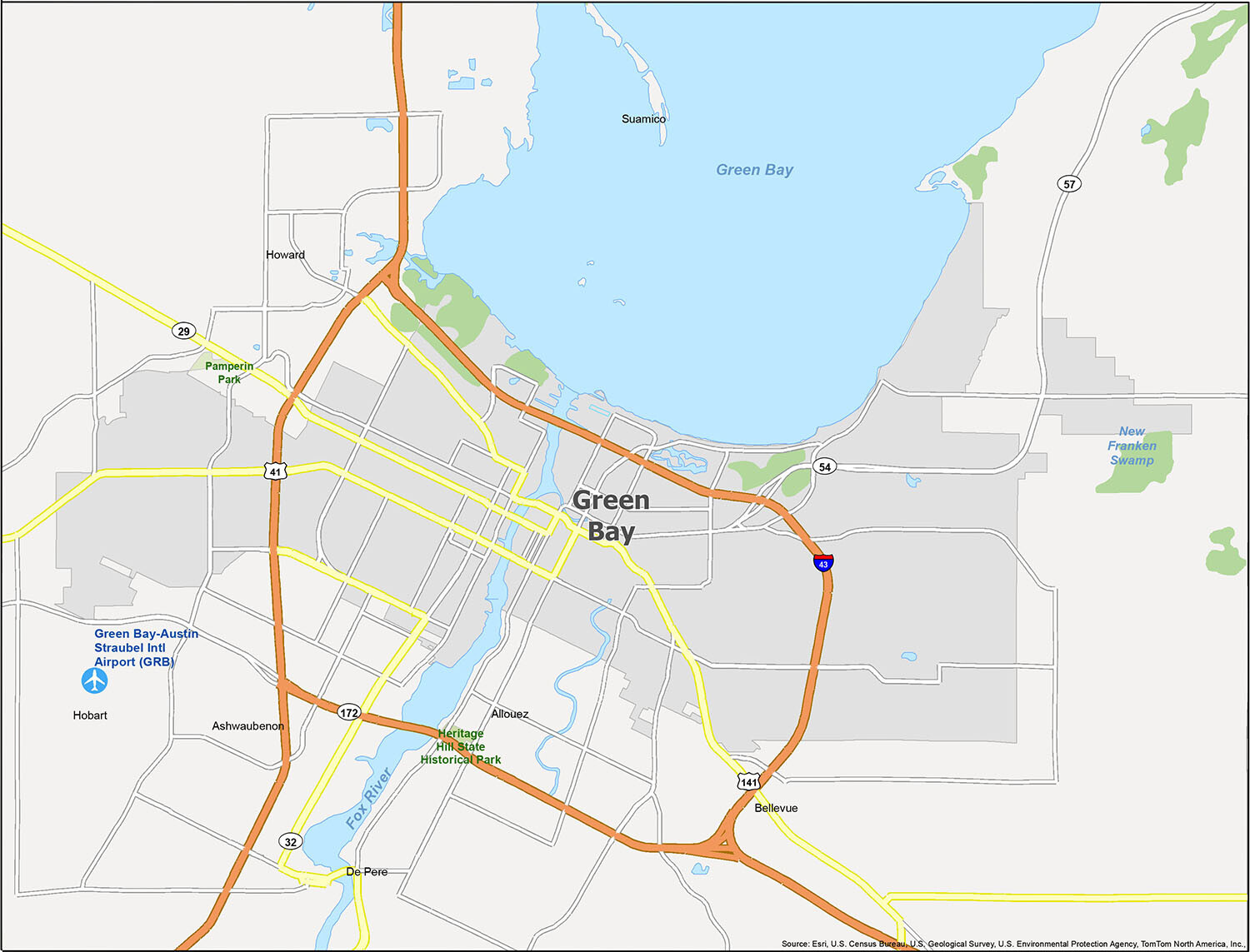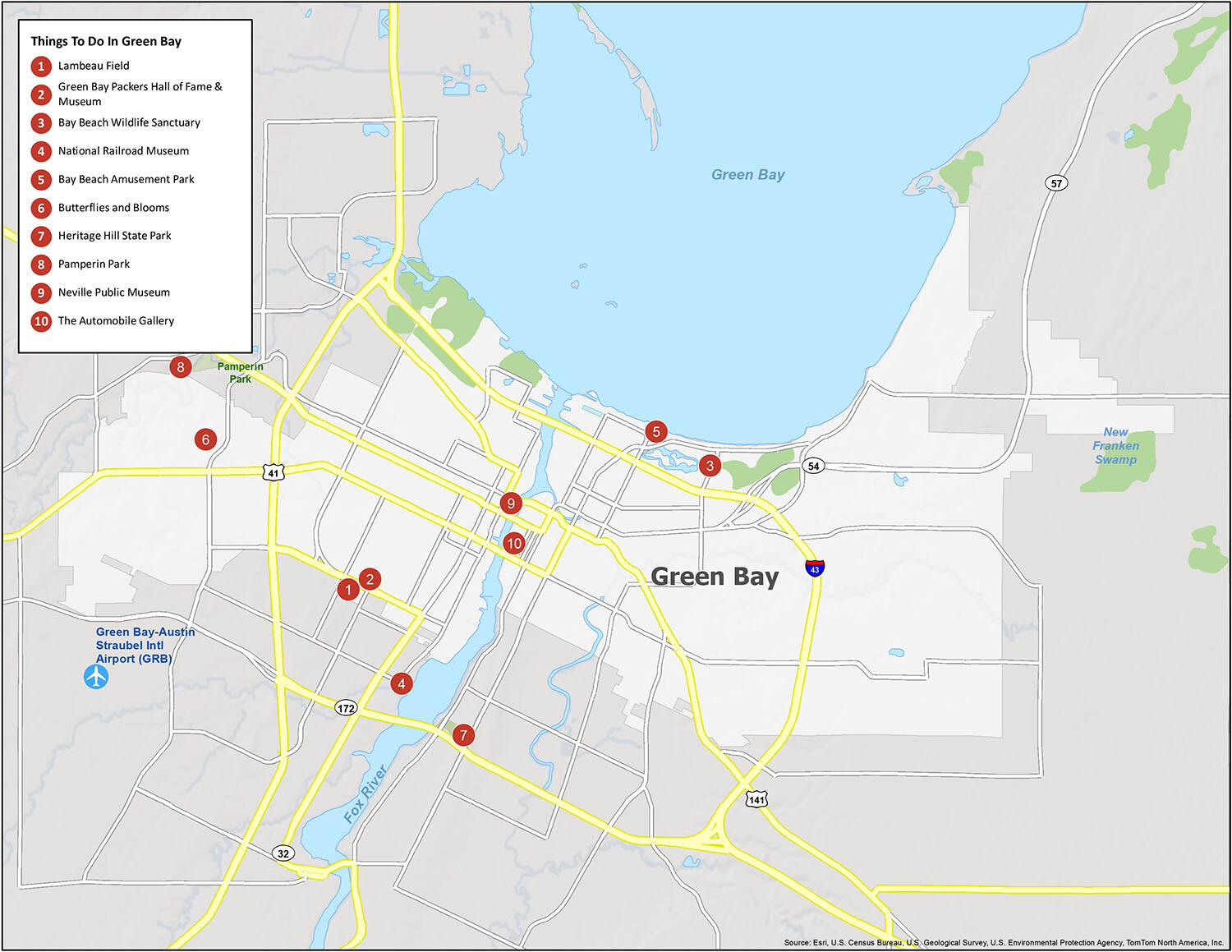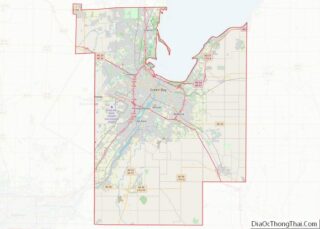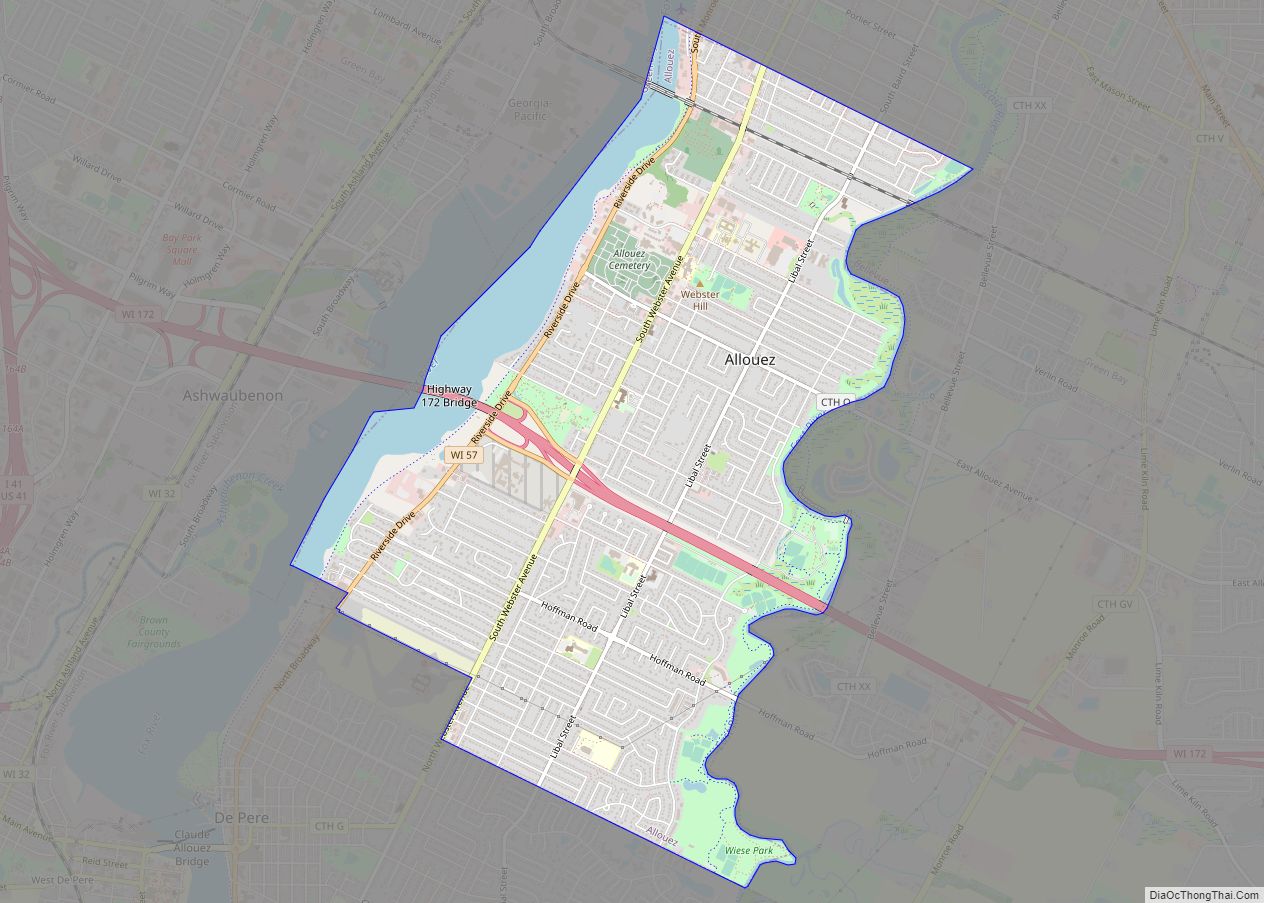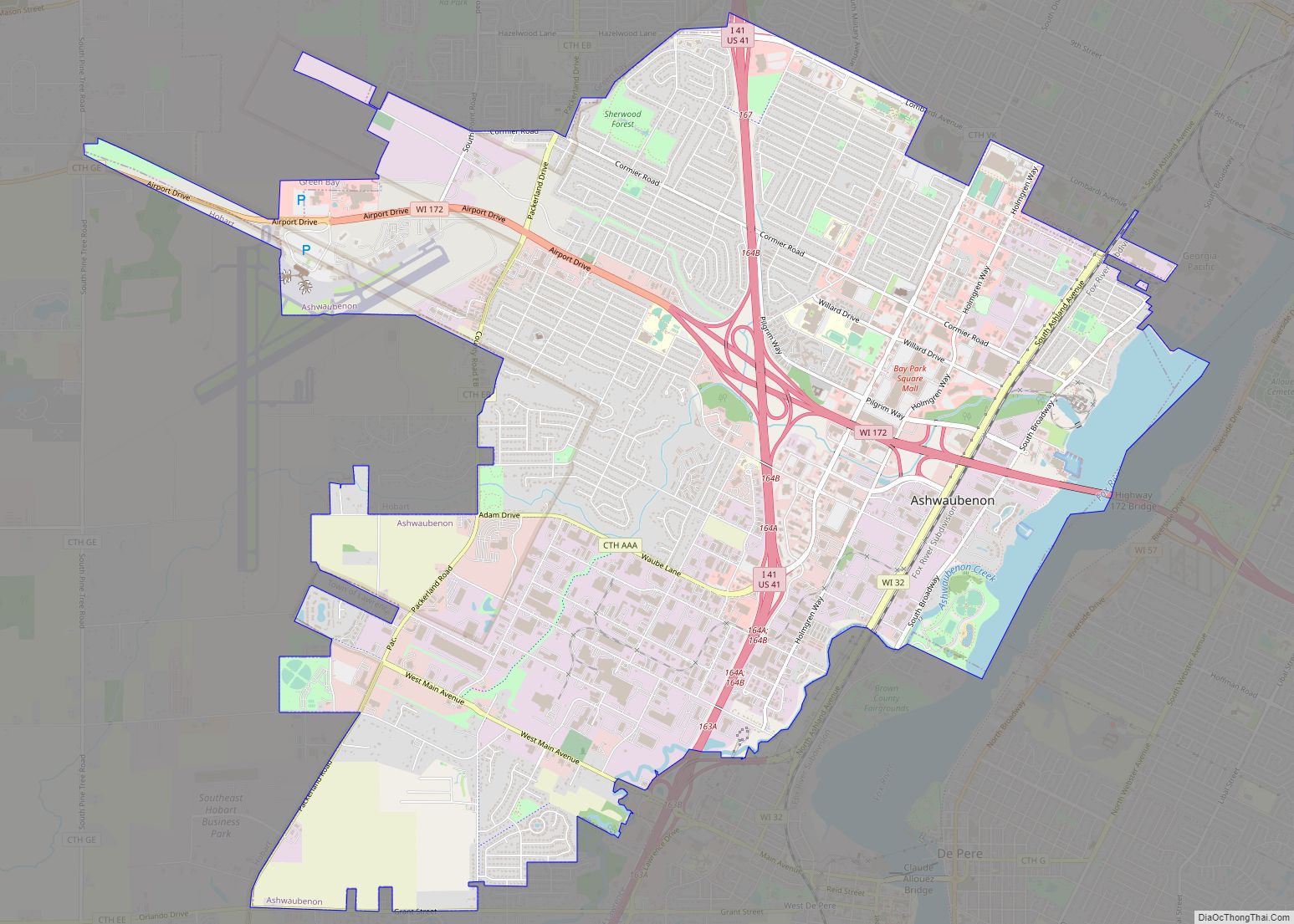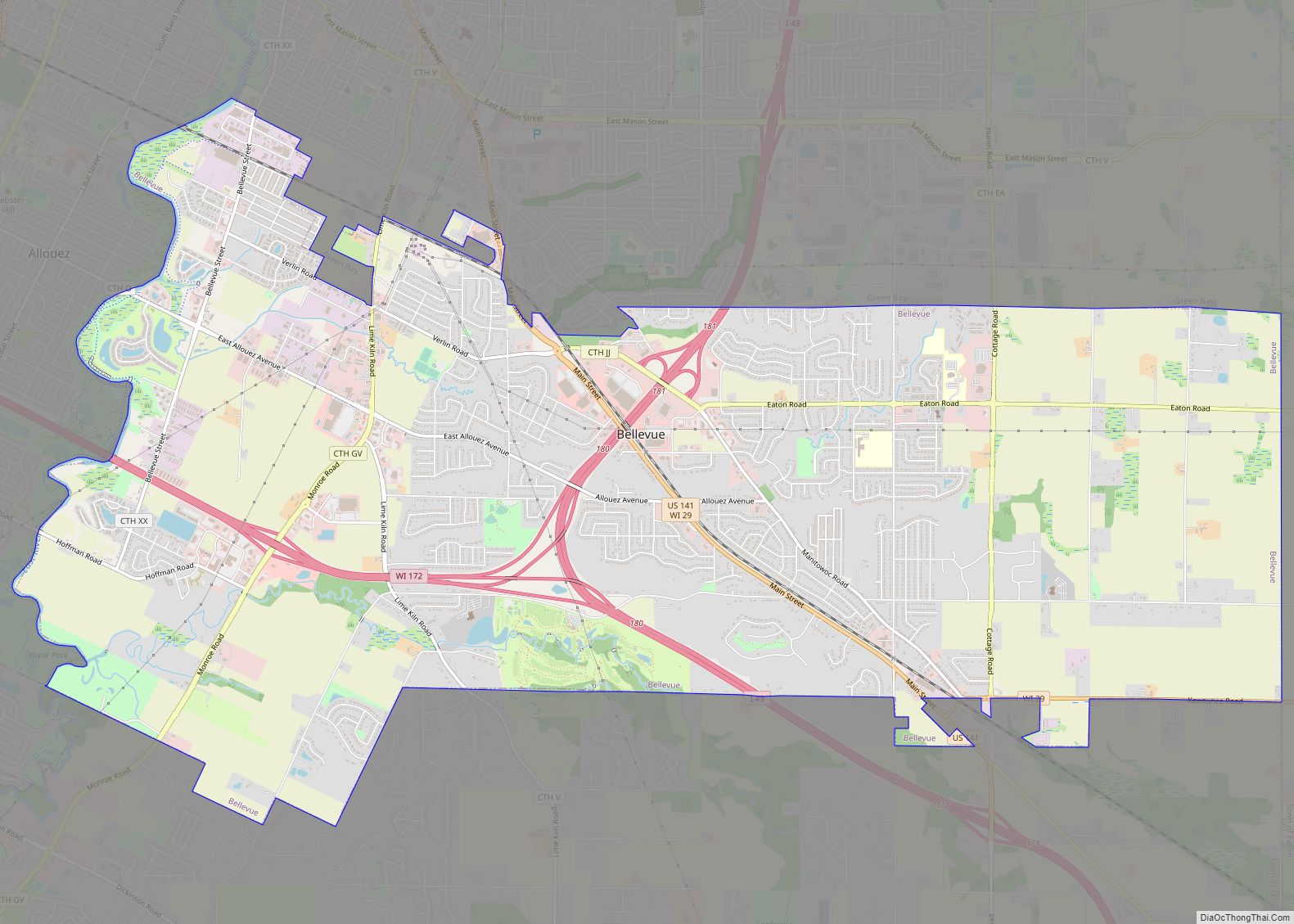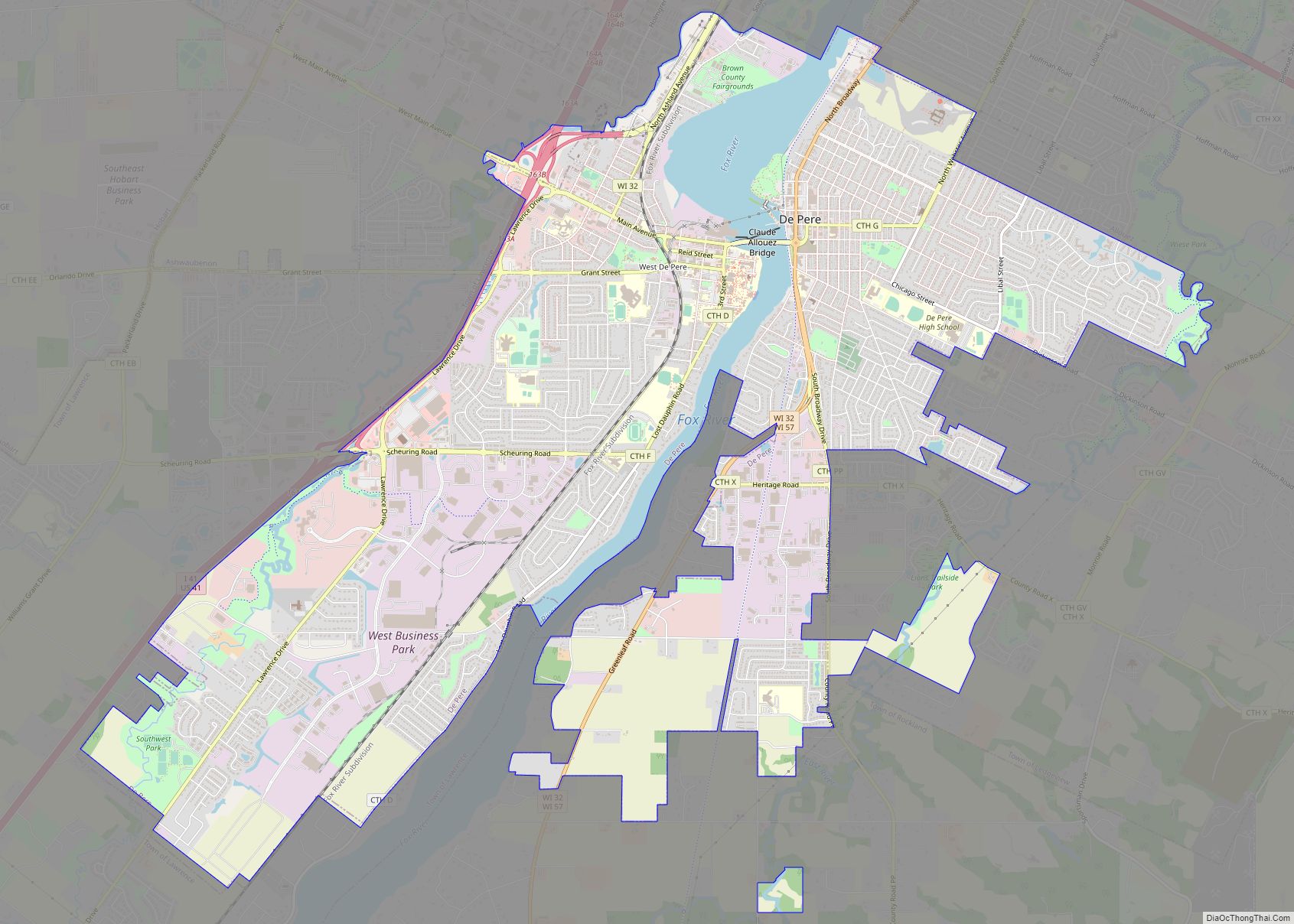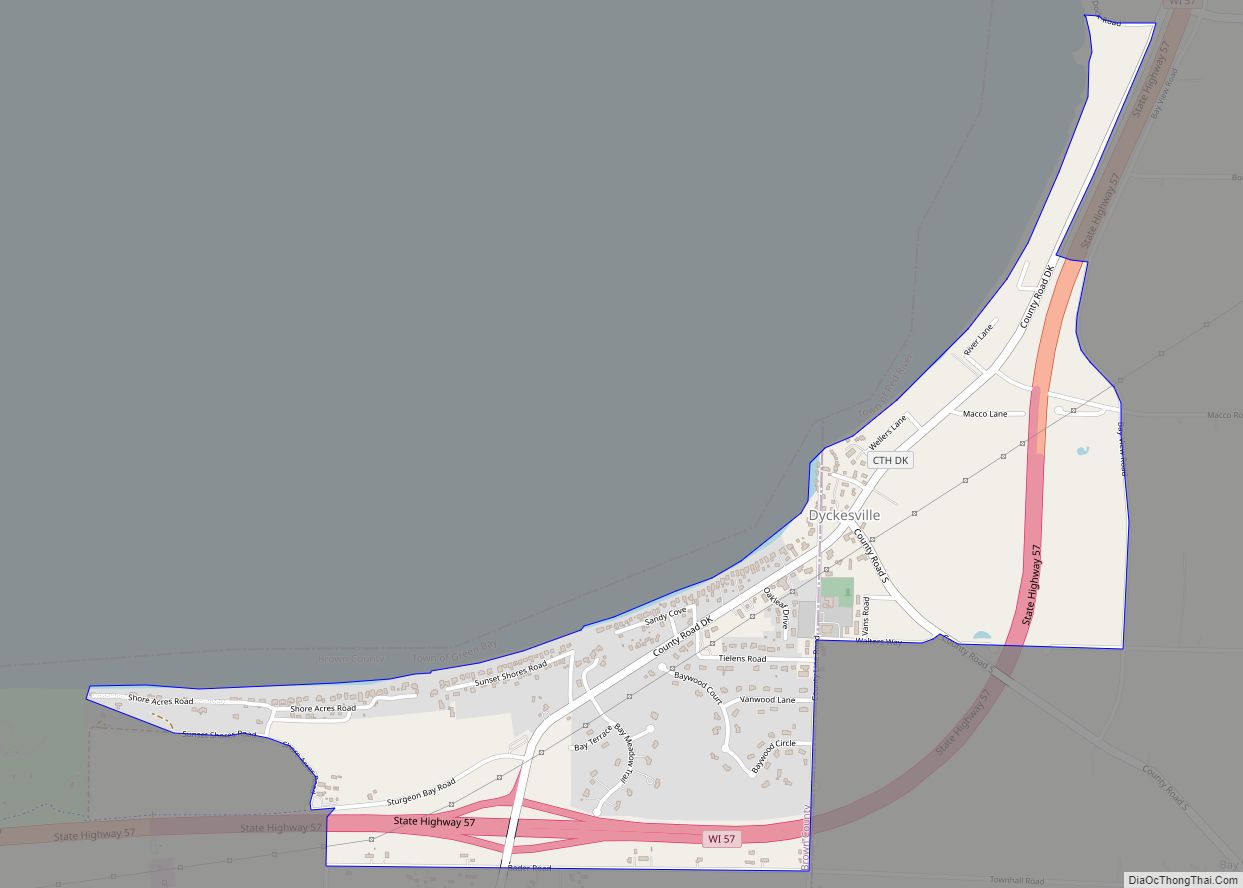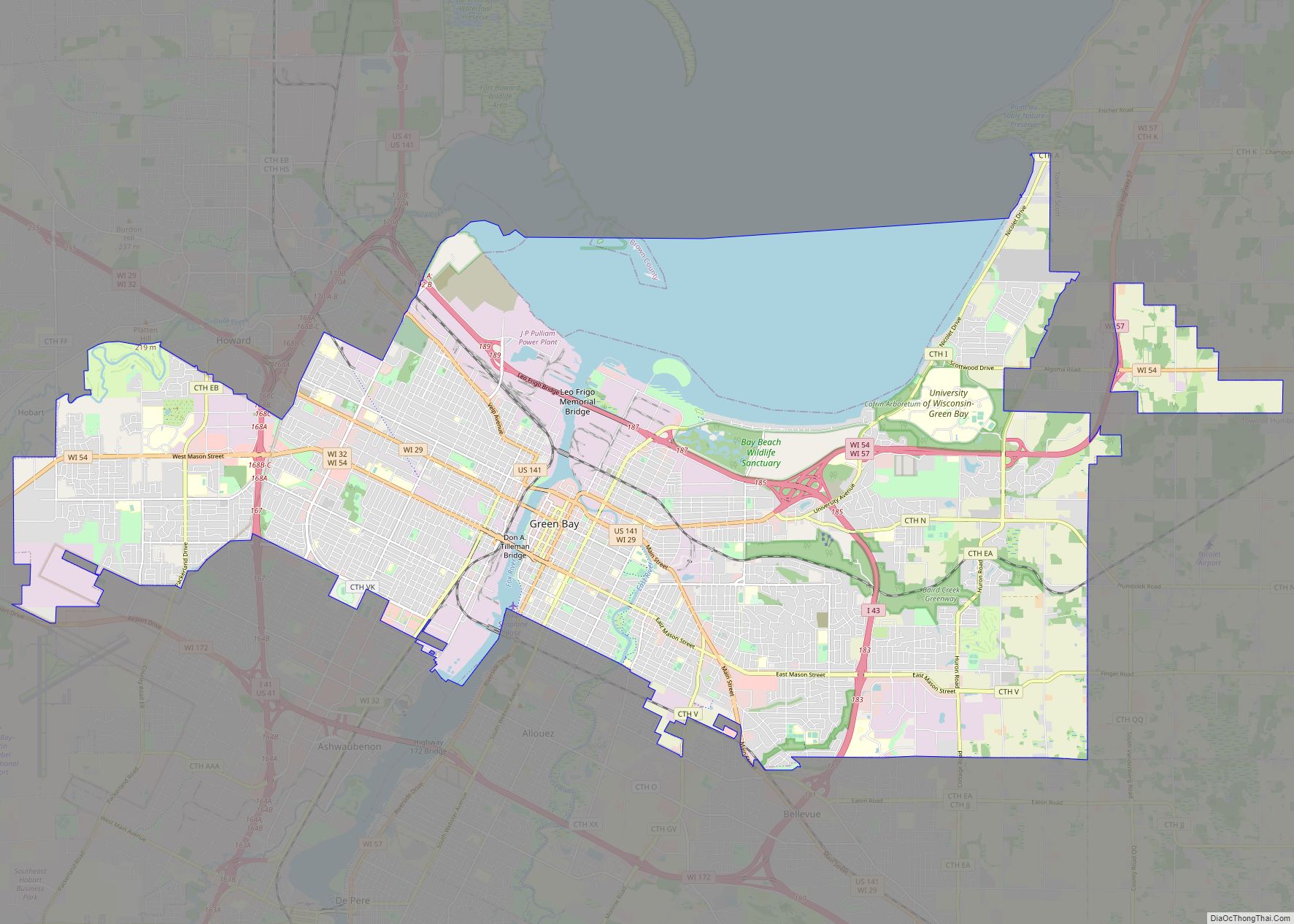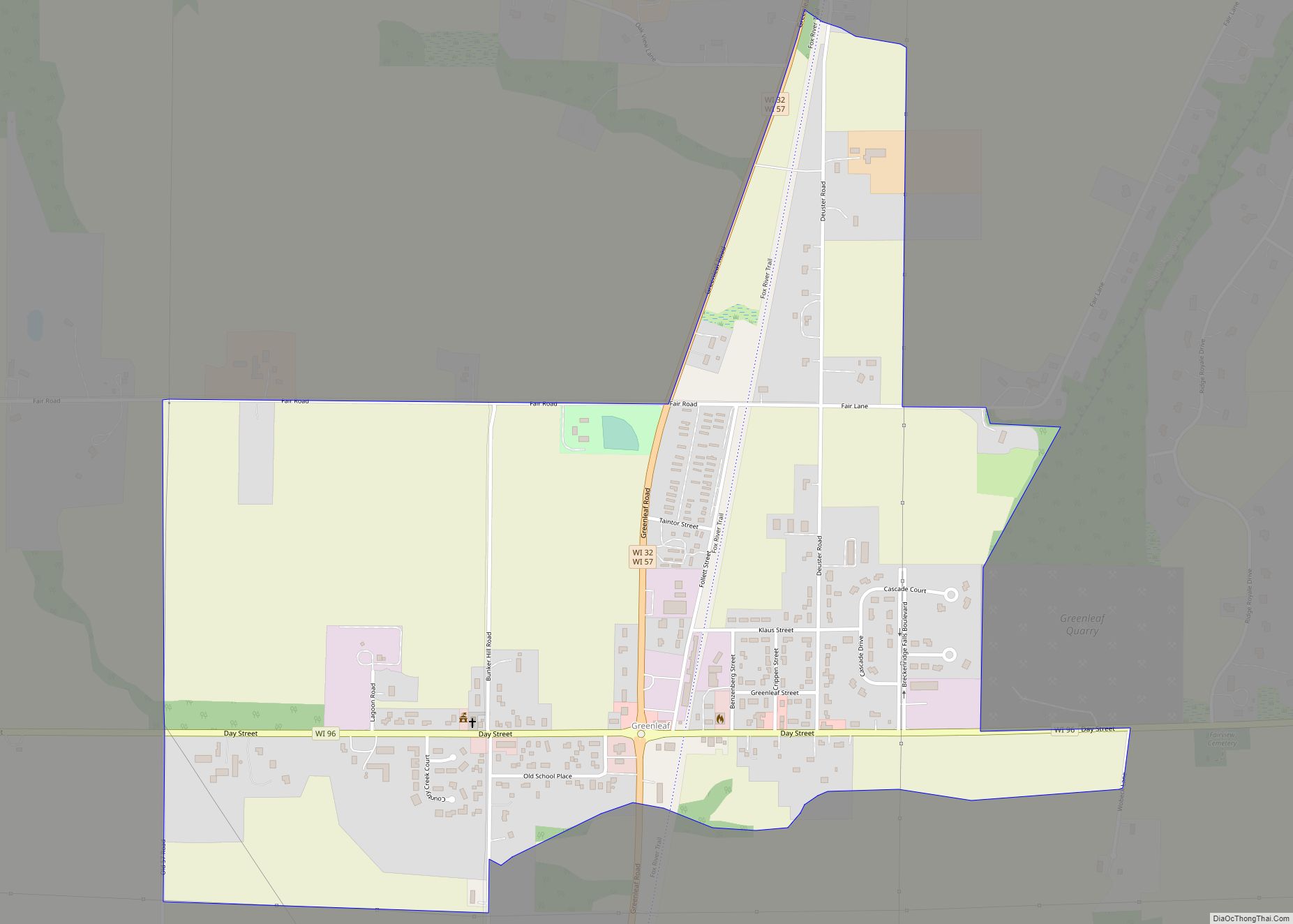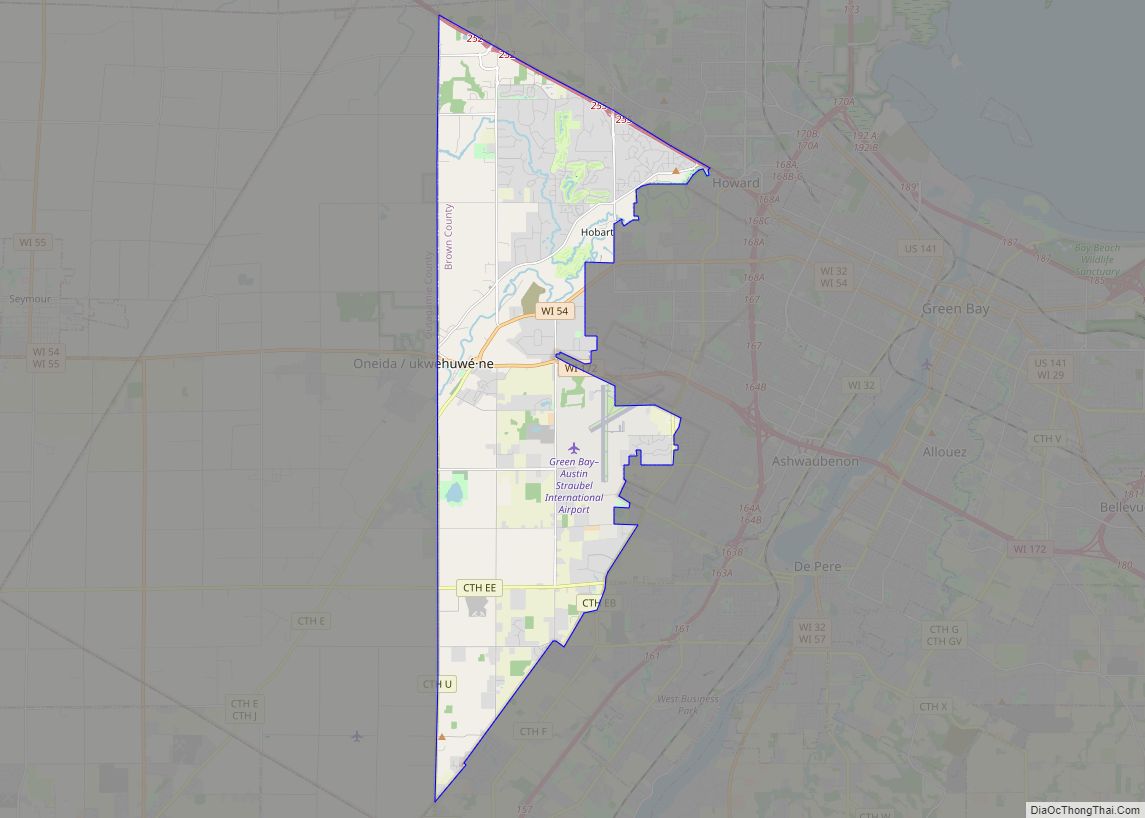Green Bay is a city in the U.S. state of Wisconsin. The county seat of Brown County, it is at the head of Green Bay (known locally as “the bay of Green Bay”), a sub-basin of Lake Michigan, at the mouth of the Fox River. As of the 2020 Census, Green Bay had a population of 107,395, making it the third-largest in the state of Wisconsin, after Milwaukee and Madison, and the third-largest city on Lake Michigan, after Chicago and Milwaukee.
Green Bay is the principal city of the Green Bay Metropolitan Statistical Area, which covers Brown, Kewaunee, and Oconto counties. Green Bay is well known for being the home city of the National Football League (NFL)’s Green Bay Packers.
| Name: | Green Bay city |
|---|---|
| LSAD Code: | 25 |
| LSAD Description: | city (suffix) |
| State: | Wisconsin |
| County: | Brown County |
| Elevation: | 581 ft (177 m) |
| Land Area: | 45.48 sq mi (117.80 km²) |
| Water Area: | 10.28 sq mi (26.62 km²) |
| Population Density: | 2,299.38/sq mi (887.79/km²) |
| ZIP code: | 54301-08, 54311, 54313, 54324, 54344 |
| Area code: | 920 |
| FIPS code: | 5531000 |
| GNISfeature ID: | 1565801 |
| Website: | greenbaywi.gov |
Explore Green Bay and its surrounding areas with this Green Bay map. This map shows major highways/roads, reference information, and things to do in the city. Print it off before you go to help explore the city and its surrounding areas. Get close and personal in our interactive Google Map of Green Bay, Wisconsin.
Online Interactive Map
Click on ![]() to view map in "full screen" mode.
to view map in "full screen" mode.
The Green Bay area has a lot to offer. From casinos and museums to parks and lakes, there is a lot to see and do in Green Bay. Explore the City of Green Bay and the surrounding areas from this interactive map that shows you where to go, what places are nearby, and where you can find things to do. This map is a great way to explore the area such as the Fox River that flows through it and empties into the large water body Green Bay to the northeast.
Green Bay location map. Where is Green Bay city?
History
Samuel de Champlain, the founder of New France, commissioned Jean Nicolet to form a peaceful alliance with Native Americans in the western areas, whose unrest interfered with French fur trade, and to search for a shorter trade route to China through Canada. Nicolet and others had learned from other First Nations of the Ho-Chunk (Winnebago) people, who identified as “People of the Sea”, and believed they must reside on or near an Ocean. Champlain had also heard about natural resources in the area, including fertile soil, forests, and animals. Nicolet began his journey for this new land shortly before winter in 1634. In what later became a French fur-trading route, he sailed up the Ottawa River, through Lake Nipissing and down the French River to Lake Huron, then through the straits of Michilimackinac into Lake Michigan. He is believed to have landed at Red Banks, near the site of the modern-day city of Green Bay, Wisconsin.
From the trading post La Baie des Puants to the town La Baie verte
Nicolet founded a small trading post here in 1634, originally named La Baye or La Baie des Puants (French for “the Bay of Stinking Waters”). Nicolet’s settlement was one of the oldest European permanent settlements in America.
When Nicolet arrived in the Green Bay area, he encountered the Menominee, who occupied this territory. He also met the Ho-Chunk (also known as the Winnebago), a people who spoke a Siouan language.
The Winnebago hunted and fished, and also cultivated corn, beans, squash, and tobacco. Wild rice, which they had incorporated as a dietary staple, grew in abundance along the riverbanks. The women regularly harvested and cooked this, along with a wide variety of nuts, berries, and edible roots which they gathered in the woods. The men typically hunted and fished for food, and the women processed game and other foods in cooking. They prepared and made clothing from the furs, as well as using other parts of animals to make tools, cord, etc. Women also had a role in the political process, as no action could be taken without agreement of half of the women. Nicolet stayed with this tribe for about a year, becoming an ally. He helped open up opportunities for trade and commerce with them before returning to Quebec.
A few months after Nicolet returned to Quebec, Champlain died. His death halted other journeys to La Baie Verte (French for “The Green Bay”). Père Claude Allouez sent Nicolas Perrot to La Baie. After this, the French avoided the area for some decades, because of the intensity of First Nations and European conflicts in the east. In 1671, a Jesuit Mission was set up in the area. A fort was added in 1717 and gradually associated development took place. The town was incorporated in 1754.
Great Britain took control of some French areas during the Seven Years’ War, known as the French and Indian War in some areas of North America. They took control of this town in 1761. After the British defeated the French in 1763, France ceded its lands east of the Mississippi in North America.
The first permanent settlers were Charles de Langlade and his family from Quebec, who moved to Green Bay in 1765. They are considered the first European settlers in the present-day state of Wisconsin. Langlade, called the “Founder and Father of Wisconsin”, was a métis or mixed-race, son of a French-Canadian father and an Ottawa woman. He grew up with his mother’s family among the Ottawa people and became a war chief. The Ottawa were allies of the French during the French and Indian War, and Langlade is credited with planning the ambush of British General Braddock and George Washington. His family was followed to Green Bay by the Grignons, Porliers and Lawes, who brought French-Canadian culture with them. Colorful “jack-knife Judge” Reaume dispensed British justice in the territory after Great Britain took it over following the war. These early ethnic French settlers set the tone for many who followed.
The British take-over
The British gradually took over Wisconsin during the French and Indian War, taking control of Green Bay in 1761 and gaining control of all of Wisconsin in 1763. Like the French, the British were interested in little but the fur trade. In 1791, two free African Americans set up a fur trading post among the Menominee at present day Marinette. The first permanent settlers, mostly French Canadians, some Anglo-New Englanders and a few African American freedmen, arrived in Wisconsin while it was under British control. Charles Michel de Langlade is generally recognized as the first settler, establishing a trading post at Green Bay in 1745, and moving there permanently in 1764. Settlement began at Prairie du Chien around 1781. The French residents at the trading post in what is now Green Bay, referred to the town as “La Bey,” however British fur traders referred to it as “Green Bay,” because the water and the shore assumed green tints in early spring. The old French title was gradually dropped, and the British name of “Green Bay” stuck. The region coming under British rule had virtually no adverse effect on the French residents as the British needed the cooperation of the French fur traders and the French fur traders needed the goodwill of the British. During the French occupation of the region licenses for fur trading had been issued scarcely and only to select groups of traders, whereas the British, in an effort to make as much money as possible from the region, issued licenses for fur trading freely, both to British and French residents. The fur trade in what is now Wisconsin reached its height under British rule, and the first self-sustaining farms in the state were established as well. From 1763 to 1780, Green Bay was a prosperous community which produced its own foodstuff, built graceful cottages and held dances and festivities.
After Independence
The Green Bay area was still under British control until the 1783 treaty formally ended the American Revolutionary War. Following the War of 1812, which in part was over disputes related to the border with Canada, the United States built Fort Howard on the Fox River in 1816 to protect its northern border. Doty, Whitney, Arndt, Baird and Martin were among the many British-American settlers whose numbers pushed French culture into the background.
The Erie Canal was completed in 1825, linking New England with the Great Lakes. This led to the advance of Green Bay as a trading center. The end of the Black Hawk War in 1832 also gave impetus to settlement of the region. Most of the settlers were farmers from New England who began using the Erie Canal to pour into Wisconsin. As more and more New England settlers arrived, Green Bay developed into a trading center for this population.
Wisconsin’s first newspaper, The Green Bay Intelligencer, was started in 1833 by Albert Ellis and John V. Suydam. The borough of Green Bay, created in 1838, is the center of the present-day city. The borough combined the town of Astoria (a company town of the American Fur Company), with Navarino, platted by Daniel Whitney. Before Wisconsin became a state in 1848, its commerce was based on the fur trade, which became dominated by John Jacob Astor’s American Fur Company. After statehood, there was a shift away from fur trading toward lumbering. “For a short time in 1860s and 1870s, iron smelting in charcoal kilns rivaled the timber industry while the port handled increasing amounts of fuel, feed, and lumber. Today’s major local industry had its start in 1865 when the first paper mill was built.”
By 1850 the town had a population of 1,923. The town was incorporated as the city of Green Bay in 1854. The Green Bay Area Public School District was founded in 1856. Throughout the 1850s, word spread of America’s cheap land and good soil, bringing in an influx of Belgian people, German, Scandinavian, Irish and Dutch immigrants, each adding to the culture. The greatest concentration of newcomers came from Belgium. They cleared the land to farm and build their homes.
The railroad arrived in the 1860s. The three railroads that would reach Green Bay were the Chicago & North Western (C&NW), SOO Line, (SOO), and the Milwaukee Road (MILW). These railroads were highways which allowed people and products to travel all over the state, increasing business and trade opportunities. The area was able to grow and enrich itself with the use of the and the plentiful timber resources. This led to the paper industry becoming the major employer in Green Bay, and opened up the port for international trade.
Large numbers of Belgians immigrated to Green Bay in the thirty-year period between 1880 and 1910. Significant numbers of English immigrants, many having lived first in Canada, also moved to Green Bay during this period, usually arriving as large families. There was also a small Dutch community in Green Bay at this time. Green Bay had a larger portion of first generation immigrants from France than any other city in Wisconsin at this time as well.
In 1934, President Franklin D. Roosevelt came to Green Bay to honor its tercentenary. By 1950, the city had a population of 52,735. In 1964, the Town of Preble was consolidated with the city of Green Bay.
Green Bay Road Map
Whether you’re planning a trip, an adventure, or if you’re just curious about what’s going on in this great American city, this Green Bay road map is the perfect tool for you. If you’re thinking about taking a road trip, this map shows interstates like the I-41 and I-43, US highways like US 29, 32, 54, 57, and 141, and major roads like 12th Ave, Algoma Rd, Ashland Ave, Atkinson Dr, Bader St, Bellevue St, Broadway, and more. Print this map before you go and you’ll never get lost. But if you’re going outside Green Bay, use our Wisconsin road map for highway and road information.
Explore the city of Green Bay with this interactive map! Get a bird’s-eye view of the city and its attractions. This map is an excellent resource for vacation planning and for your day-to-day trips. Get a comprehensive overview of the entire city and its key areas to visit. Plan your next trip to Green Bay with this map and see what’s around you!
Green Bay Austin Straubel International Airport (GRB) is the main airport serving the city. Green Bay and De Pere are the two cities, while Allouez, Ashwaubenon, Bellevue, Hobart, Howard, and Suamico are the villages. The water features include Green Bay, Fox River, and New Franken Swamp. Pamperin Park and Heritage Hill State Historical Park are two of the parks in the area.
10 things to do in Green Bay city
When you are planning a trip to Green Bay, Wisconsin, make sure to add these attractions to your list. Whether you are looking for a day of fun or a weekend getaway, Green Bay has something for everyone.
Planning a vacation to Green Bay, Wisconsin can be a daunting task, but with this map of local attractions, you can easily explore the city and make the most of your time. From Lambeau Field and the Packers Hall of Fame and Museum to the Bay Beach Wildlife Sanctuary and the National Railroad Museum, there are plenty of attractions to keep you entertained. So, take a trip to Green Bay, Wisconsin and experience all it has to offer.
Green Bay city Satellite Map
Geography
Green Bay is in the eastern part of Wisconsin at the mouth of the Fox River. Today, Interstate 43 meets Interstate 41 (also U.S. Route 41) in Green Bay, about 90 miles (140 km) north of Milwaukee.
According to the United States Census Bureau, the city has a total area of 55.76 square miles (144.41km), of which 45.48 square miles (117.79km) is land and 10.28 square miles (26.62km) is water.
About 14% of the city of Green Bay is inside the Oneida Nation of Wisconsin reservation.
Climate
Green Bay has a humid continental climate (Köppen climate classification Dfb), with some moderation due to the city’s proximity to Lake Michigan. Like other cities with this type of climate, there are four distinct seasons, often with severe or extreme variation between them in terms of temperature and precipitation. Green Bay experiences warm, humid summers and cold, snowy winters. The variance in temperature and precipitation between months is severe and often extreme. Tornadoes are rare in the Green Bay area, with the strongest being an F3 tornado that hit the community of Pittsfield on June 26, 1969.
Monthly mean temperatures range from 16.6 °F (−8.6 °C) in January to 69.1 °F (20.6 °C) in July. In July, the warmest month, the average high temperature is 81.2 °F (27.3 °C). There are 6.1 days of 90 °F (32 °C)+ highs, 68 days where the high remains at or below freezing, and 19 days with sub-0 °F (−18 °C) lows annually. From December to February, even during thaws, the temperature rarely reaches 50 °F (10 °C). Extremes have ranged from −36 °F (−38 °C) on January 21, 1888, to 104 °F (40 °C) on July 13, 1936.
The wettest month in Green Bay is August, when 3.77 inches (95.8 mm) of precipitation falls, mostly in the form of rainfall from thunderstorms. The driest month in Green Bay is February, when the majority of precipitation falls as low moisture-content snow due to cold, dry air. On average, 1.01 inches (25.7 mm) of precipitation falls in February.
See also
Map of Wisconsin State and its subdivision:- Adams
- Ashland
- Barron
- Bayfield
- Brown
- Buffalo
- Burnett
- Calumet
- Chippewa
- Clark
- Columbia
- Crawford
- Dane
- Dodge
- Door
- Douglas
- Dunn
- Eau Claire
- Florence
- Fond du Lac
- Forest
- Grant
- Green
- Green Lake
- Iowa
- Iron
- Jackson
- Jefferson
- Juneau
- Kenosha
- Kewaunee
- La Crosse
- Lafayette
- Lake Michigan
- Lake Superior
- Langlade
- Lincoln
- Manitowoc
- Marathon
- Marinette
- Marquette
- Menominee
- Milwaukee
- Monroe
- Oconto
- Oneida
- Outagamie
- Ozaukee
- Pepin
- Pierce
- Polk
- Portage
- Price
- Racine
- Richland
- Rock
- Rusk
- Saint Croix
- Sauk
- Sawyer
- Shawano
- Sheboygan
- Taylor
- Trempealeau
- Vernon
- Vilas
- Walworth
- Washburn
- Washington
- Waukesha
- Waupaca
- Waushara
- Winnebago
- Wood
- Alabama
- Alaska
- Arizona
- Arkansas
- California
- Colorado
- Connecticut
- Delaware
- District of Columbia
- Florida
- Georgia
- Hawaii
- Idaho
- Illinois
- Indiana
- Iowa
- Kansas
- Kentucky
- Louisiana
- Maine
- Maryland
- Massachusetts
- Michigan
- Minnesota
- Mississippi
- Missouri
- Montana
- Nebraska
- Nevada
- New Hampshire
- New Jersey
- New Mexico
- New York
- North Carolina
- North Dakota
- Ohio
- Oklahoma
- Oregon
- Pennsylvania
- Rhode Island
- South Carolina
- South Dakota
- Tennessee
- Texas
- Utah
- Vermont
- Virginia
- Washington
- West Virginia
- Wisconsin
- Wyoming
